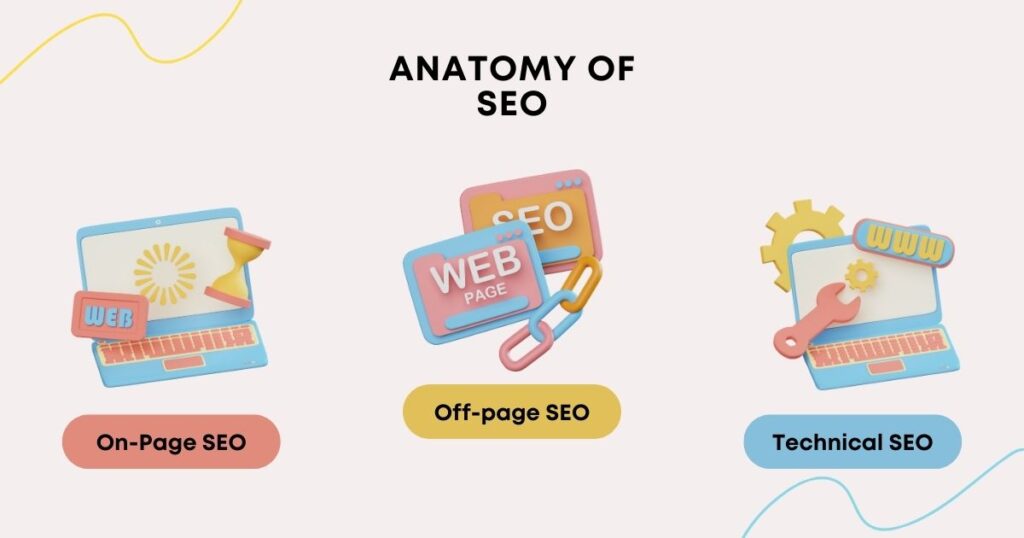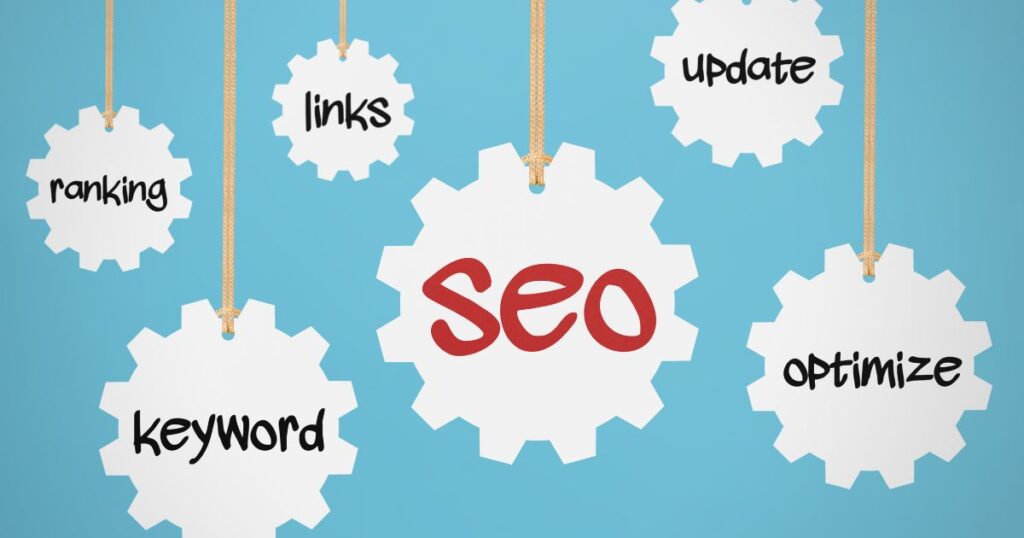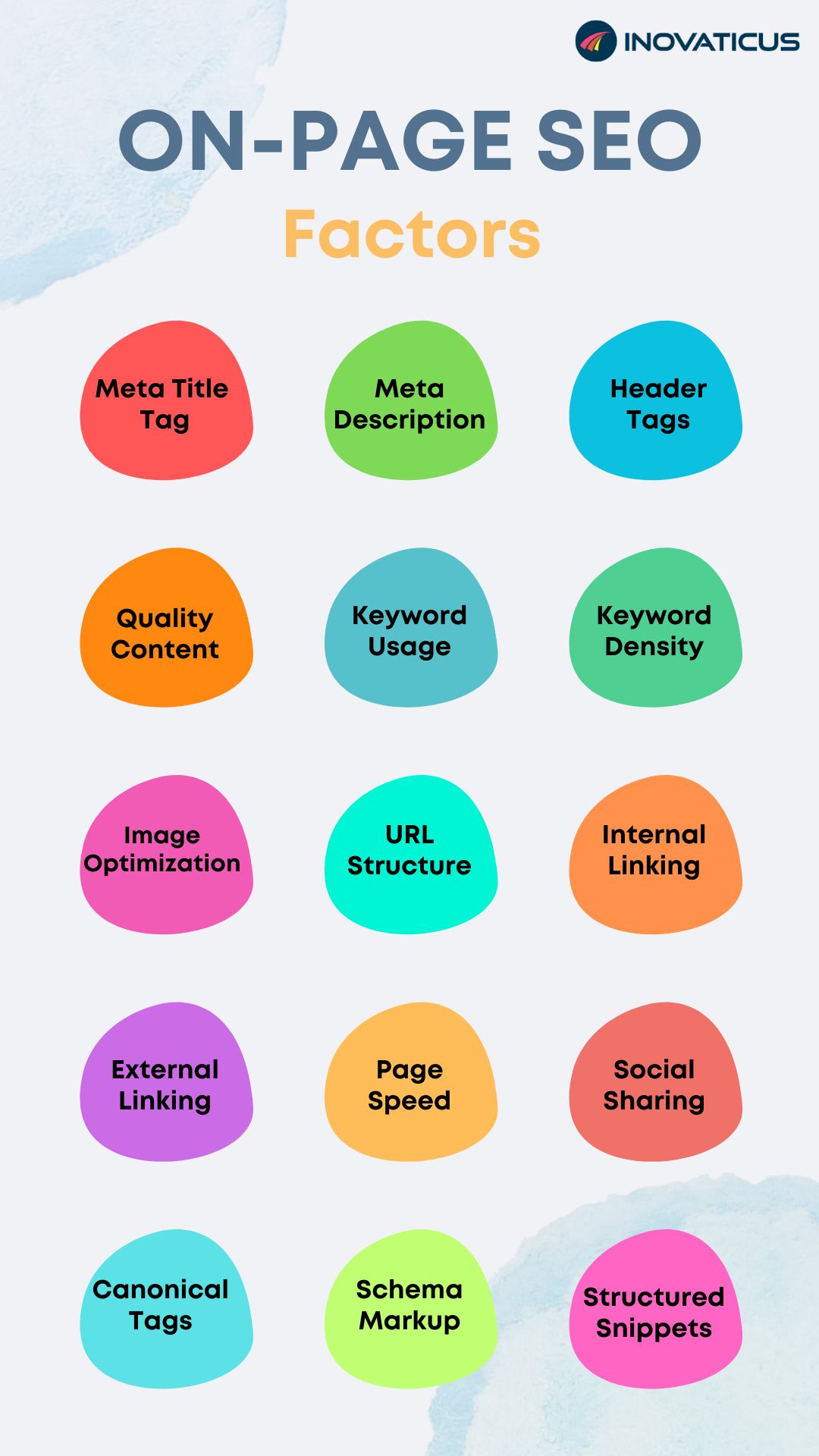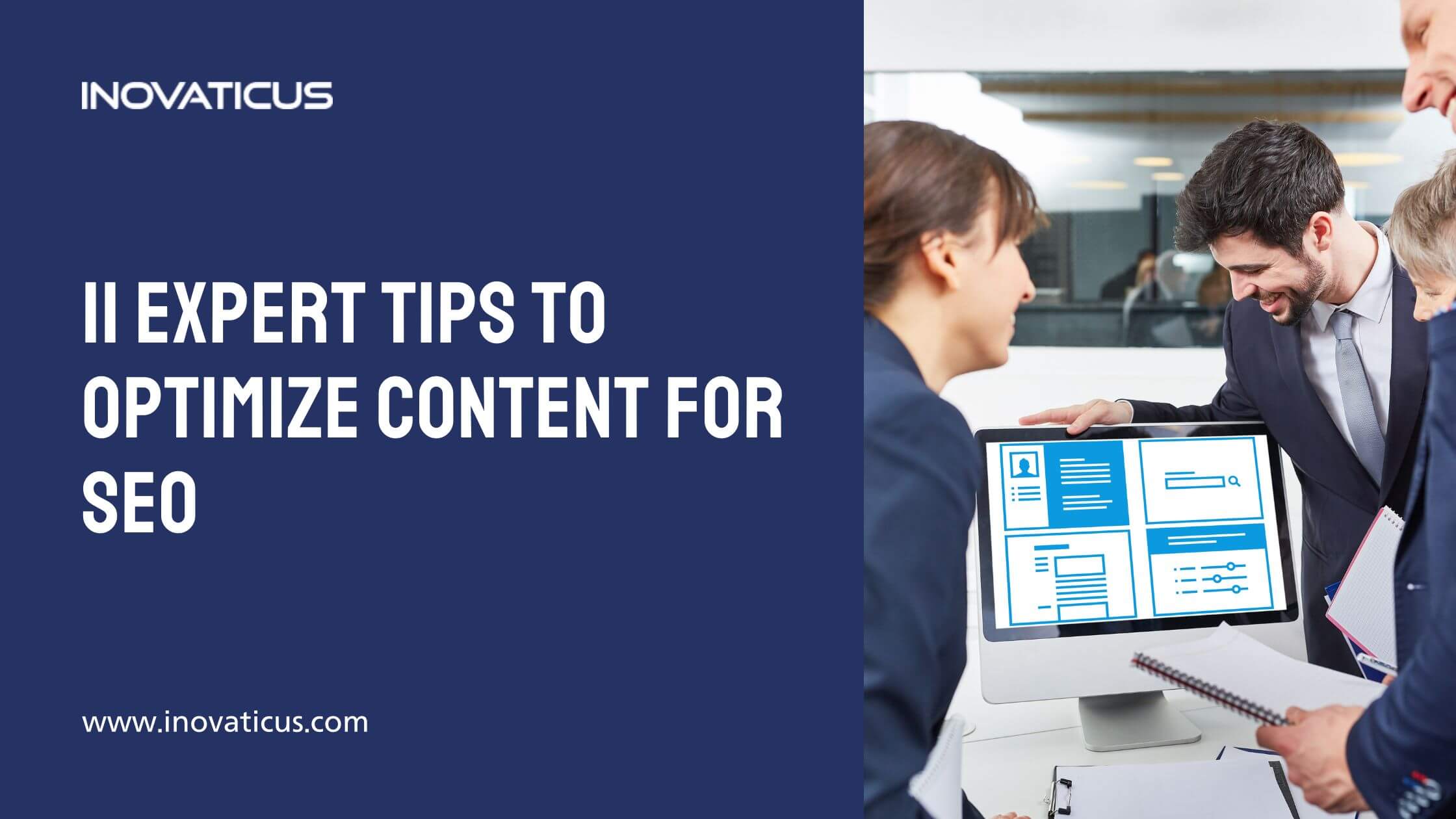Who doesn’t love getting organic (free) traffic from search engines like Google for growing their business? However, getting noticed by search engines and users is not very easy. You need to have a thorough knowledge of SEO and the various off-page and on-page seo factors that you need to focus on.
In this article, we’ll know what on-page SEO factors are and how they help your site rank high on the Search Engine Result Pages. From title tags to meta descriptions, header tags to keyword usage, and content quality to image optimization, we’ll cover it all. You’ll learn the importance of each on-page element and how to optimize them effectively.
But it doesn’t stop there. We’ll also delve into E-A-T (Experience, Expertise, Authoritativeness, and Trustworthiness) – a concept that Google uses to evaluate your website’s credibility.
To ensure long-term success, we’ll discuss monitoring and tweaking strategies for your on-page SEO efforts. So, get ready to take your rankings to new heights with this ultimate guide!
Table of Contents
Understanding Google’s Ranking Algorithm
Google’s ranking algorithm is a complex and ever-changing set of algorithms that determines where web sites appear in search results. It considers a plethora of factors, broadly categorized into on-page, off-page, and technical SEO.
- On-Page SEO: This refers to optimizing elements that are on the website itself, such as content, title tags, meta descriptions, and images. On-page SEO aims to ensure that content is high-quality, relevant, and structured in a way that is easily digestible both for users and search engine crawlers.
- Off-Page SEO: This encompasses actions taken outside of your website that affect your rankings within search engine results pages. The most notable aspect of off-page SEO is the building of backlinks from other websites. Social media presence, guest blogging, and brand mentions are also considered as off-page SEO factors. Essentially, off-page SEO is about building authority and trust for your website.
- Technical SEO: This involves optimizing the backend structure and foundation of your website. Technical SEO ensures that a website is fast, secure, and easily crawlable by search engines. It includes aspects such as site speed, XML sitemaps, structured data, and security.

Google’s algorithm uses these three pillars to evaluate and rank web pages. It is estimated that there are more than 200 technical, off-page and on-page SEO factors that Google looks at while ranking websites.
It’s essential to understand that excelling in one category but neglecting the others is not an effective strategy. A harmonious balance and integration of on-page, off-page, and technical SEO are necessary for achieving high rankings in Google’s search results.
What is On-Page SEO?
On-Page SEO, also known as on-site SEO, refers to the practice of optimizing various elements within a web page to improve its performance in search engine rankings. It involves fine-tuning both the content and the HTML source code of a page. The primary goal of on-page SEO is to make a web page more relevant, user-friendly, and accessible, which, in turn, boosts its visibility in search engine results pages (SERPs) for targeted keywords and phrases.
On-Page SEO is vital for achieving high SERP rankings, as it involves optimizing various elements on your website. By strategically incorporating keywords in titles, headings, and every piece of content you create, you can convey the relevance of your page to search engines.
Decoding On-Page SEO Factors
On-Page SEO is an integral component of search engine optimization that focuses on optimizing various elements on your website pages to improve search engine rankings and provide a better experience for visitors. In this section, we will decode the essential on-page SEO factors that every webmaster should be cognizant of.
1. Title Tag
The title tag is an HTML element that defines the title of a webpage. It plays a crucial role in on-page SEO by appearing as the clickable headline in search engine results pages. Optimizing the title tag is essential for improving search engine rankings. It should accurately describe the content and incorporate relevant keywords. A concise length of 50-60 characters is recommended for full display in search results. Creating unique and compelling titles enhances website visibility, attracting more clicks.
2. Meta Description
A meta description is a concise summary of your webpage’s content, displayed in search engine results. It plays a vital role in enticing users to click on your link.
Aim for an ideal length of around 150-160 characters for maximum impact. Don’t forget to include relevant keywords to boost your search engine rankings. Remember, each page should have a unique meta description that accurately reflects its content.
Craft compelling meta descriptions to optimize your on-page SEO and improve your visibility in search results.
3. Header Tags
Header tags, ranging from H1 to H6, are essential HTML elements for on-page SEO and content readability. They structure content into sections and sub-sections, making it more user-friendly.
Including keywords in header tags, especially the H1, helps search engines understand content topics. The hierarchical nature of header tags from H1 to H6 helps emphasize content importance. They also improve content accessibility for screen readers, and a well-structured page can lead to increased user engagement.
With header tags, you can guide search engines and users through your content, enhancing readability and the overall user experience. By correctly implementing header tags, you make it easier for search engines and users to find and comprehend the information you’re presenting.
In essence, header tags are crucial for enhancing content readability, accessibility, and optimizing for search engines.
4. High-Quality Content
The importance of high-quality content as one of the on-page SEO factors cannot be overstated. Content is the foundation upon which all other SEO elements are built. When content is unique, informative, and well-written, it engages the audience and keeps them on the page longer, which is a positive signal to search engines.
High-quality content is more likely to earn backlinks from other websites and more social media shares, which is a strong indicator of authority and relevance. Additionally, high-quality content allows for the natural integration of keywords and topics that search engines use to understand the context of your page.
It’s not just about satisfying algorithms, though; high-quality content establishes trust and authority among your audience. It answers their questions, solves their problems, and provides the value they are seeking, which in turn can lead to higher conversion rates and customer retention.
In an age where users are inundated with information, standing out with high-quality content is an essential aspect of on-page SEO that leads to higher rankings and greater online success.
5. Keyword Usage and Distribution
One of the critical on-page SEO factors that demands careful attention is Keyword Usage and Distribution. This encompasses the strategic incorporation and dispersion of keywords throughout your webpage content. When executed properly, it helps search engines comprehend the central theme of your content, thereby influencing its rank.
Keyword Usage refers to the inclusion of specific terms and phrases, known as keywords, within your content. These are what users typically enter into search engines when looking for information. Integrating relevant keywords is pivotal for search engines to discern the subject matter of your content and index it accordingly. It’s imperative that the employment of keywords appears natural and does not impede the content’s flow or readability.
Moving on to Keyword Distribution, this involves the deliberate scattering of keywords throughout your content. The optimal approach is to ensure that your primary keyword is present in essential areas like the title, the introductory paragraph, and intermittently across the content. Moreover, it is advisable to utilize variations and synonyms of the keyword, along with LSI (Latent Semantic Indexing) keywords, to establish context and richness.
6. Keyword Density
An associated concept is Keyword Density, which is the ratio of the number of times the target keyword is used to the total word count, usually expressed as a percentage. It’s essential to circumvent over-optimization by incessantly repeating the same keywords, which can result in penalties from search engines. Instead, concentrate on a natural and balanced incorporation of keywords in your content.
To establish a balance between optimisation and readability, aim for a keyword density of 1-2%.
Optimizing keyword density can be achieved by including variations and related terms of your target keyword. This not only prevents the content from appearing spammy but also accentuates its relevance. By maintaining an ideal keyword density and ensuring astute keyword usage and distribution, you can enhance the visibility of your web pages on search engine results and draw more organic traffic.
Tip: Avoid Keyword Stuffing
In the past, many webmasters tried to game the system by including excessive numbers of keywords in their content, a practice known as keyword stuffing. This is now penalized by search engines, as it creates a poor user experience. It’s important to maintain a balance and ensure that keyword usage enhances the content rather than detracting from it.
7. Image Optimization
Proper image optimization is a critical aspect of On-Page SEO Factors. Optimizing images on your website involves more than just compressing files for faster loading. It also includes adding relevant alt text and using descriptive file names.
Alt text should provide an accurate description of the image while incorporating relevant keywords. Similarly, descriptive file names, with keywords, can enhance the visibility of your images in search engine results.
By optimizing your images effectively, you significantly improve user experience, boost organic traffic, and contribute to higher rankings in search engine results.

8. URL Structure
Having a friendly URL structure is a critical aspect of on-page SEO and can significantly impact how both users and search engines perceive your content. A friendly URL is easy to read and understand, which helps users to ascertain what the page is about even before they click on it.
For search engines, a friendly URL provides a clean structure in which they can identify keywords and understand the relevancy of your page. To create a friendly URL structure, it’s advisable to use descriptive keywords that are relevant to the content, and to avoid unnecessary characters or strings of numbers. Using hyphens to separate words can also improve readability.
For instance, a URL like www.example.com/5-tips-for-better-seo is considered more friendly and informative compared to something like www.example.com/post?id=1234.
Moreover, a logical URL structure can also be beneficial in the site’s hierarchy, helping search engines to understand the relationships between different pages, and contributing to a more organized and user-friendly site navigation.
9. Internal Linking
Internal linking plays a crucial role in on-page SEO factors. It helps organize and optimize your website, contributing to improved search engine visibility and enhanced user experience.
By strategically linking to other pages within your site, you can distribute link equity, boosting the ranking of all pages. Additionally, internal links facilitate easy navigation for visitors, allowing them to access relevant content effortlessly.
When implementing internal links, it’s important to use descriptive anchor text that accurately represents the linked page’s content and relevance. This helps both search engines and users understand the destination of the link, improving overall site structure and user navigation.
10. External Linking
External linking plays a critical role in on-page SEO factors. By linking to other websites from your own webpage, you provide valuable information about the relevance and credibility of your content. This, in turn, helps search engines better understand the context and quality of your page.
When implementing external links, it is essential to choose reputable and authoritative websites that are relevant to your content. By doing so, you establish a strong foundation for search engine optimization and boost your website’s visibility.
Moreover, external links contribute to an enhanced user experience by offering additional resources and information. By using descriptive anchor text that accurately describes the linked website or webpage, you can optimize your SEO strategy further.
11. Page Speed
Page speed, one of the most important on-page SEO factors, plays a critical role in search engine optimization. It directly impacts user experience and can contribute to higher visibility and rankings on SERPs.
To optimize your page speed, there are several best practices to follow.
- Firstly, make sure to compress and optimize your images to reduce their file size without sacrificing quality.
- Secondly, minimize your code and remove any unnecessary elements to improve loading times. Additionally, leverage browser caching to store certain elements locally, reducing the need for repeated downloads.
By focusing on page speed optimization, you can enhance your website’s performance and provide a better experience for your visitors.
12. Social Sharing
Social sharing is a crucial on-page SEO factor that significantly impacts your website’s rankings and visibility. It plays a vital role in increasing the reach and engagement of your content on social media platforms. By making it easy for visitors to share your content, you can attract more traffic and enhance your online presence.
Including social sharing buttons on your webpages allows users to effortlessly share your content with their followers, expanding your content’s reach and potential audience.
When your content gets shared on social media, it sends signals to search engines that your content is valuable and relevant, positively impacting your rankings. Additionally, social sharing can also drive traffic back to your website, increasing the chances of acquiring potential customers or clients.
To optimize social sharing, ensure that your website has visually appealing and easily shareable content. Utilize high-quality images and compelling headlines to grab users’ attention. Place social sharing buttons in prominent locations on your webpages, facilitating convenient content sharing. Remember, the more your content gets shared, the more chances it has to gain visibility and attract organic traffic.
13. Canonical Tags
Canonical tags are an important element in on-page SEO factors. They are used to indicate to search engines the preferred version of a webpage.
These HTML tags play a crucial role when dealing with multiple versions of a webpage that share similar content, such as different URLs or mobile versions. By implementing canonical tags correctly, you can prevent issues caused by duplicate content and guide search engines to index and rank the correct version of your webpage.
When using canonical tags, it’s essential to specify the full URL of the preferred version. This on-page SEO factor helps consolidate ranking signals and prevents keyword cannibalization, ultimately improving your website’s SEO.
14. Schema Markup
Schema Markup is an essential element for boosting your website’s visibility in search engine results pages. By incorporating Schema Markup, you provide detailed information to search engines about the content on your web pages, thereby improving your rankings and enhancing your visibility online.
Schema Markup allows you to provide specific details regarding your business, such as contact information, opening hours, and customer reviews. By correctly implementing Schema Markup, you can ensure that search engines understand the relevance and context of your website, resulting in better visibility and increased organic traffic.
15. Snippet Optimization
Snippet optimization is a crucial part of on-page SEO factors. It focuses on enhancing the visibility of your webpage in search engine results. The key is to create captivating meta titles and descriptions that catch the searcher’s attention.
Crafting an accurate and concise meta title, within 60 characters, ensures that users understand your page’s content at a glance. Meanwhile, a well-crafted meta description, within 160 characters, provides a concise summary and entices users to click on your link.
By optimizing these elements with relevant keywords, you can improve your page’s ranking and click-through rate, ultimately driving more organic traffic to your website.

Enhancing Rankings: The Importance of E-E-A-T In The eyes of Google
Improving search engine rankings and providing a better user experience goes beyond on-page SEO. One crucial factor to focus on is E-E-A-T – Experience, Expertise, Authoritativeness, and Trustworthiness. By understanding the significance of E-E-A-T, you can enhance your rankings and deliver valuable content to your audience.
E-E-A-T is a combination of various factors that influence how search engines perceive your website and its content. To begin with, prioritize user experience by offering valuable and relevant information. This means crafting high-quality content and articles that effectively address the searcher’s query.
Furthermore, showcase your expertise by providing well-researched and authoritative content. Establishing yourself as a trusted source of information will help you build credibility and gain the trust of your audience.
Implementing on-page SEO techniques, such as optimizing meta tags, headings, and URLs, is vital in signaling your expertise and authority to search engines. Adhering to these rules and consistently delivering valuable content will not only improve your rankings but also foster trust with your audience.
Monitoring and Tweaking On-Page SEO
Creating a successful website goes beyond initial setup. It requires continuous monitoring and tweaking of your on-site SEO.
By conducting thorough keyword research and optimizing meta tags, headings, and content, you can boost your search engine rankings.
Ensure your URL structure and internal linking are optimized to improve indexing, visibility and user experience. Check how the site is looking on desktop and mobile devices to ensure that users are getting the best experience.
Monitoring your website’s metrics through tools like Google Analytics offers invaluable insights for adjustments. Keep your website fresh by regularly updating content and optimizing page load speed. Stay ahead with a comprehensive on-page SEO strategy to climb search engine rankings and attract organic traffic.
You will also need to avoid some common SEO mistakes to ensure that you get the best rankings.
Frequently Asked Questions
What are the 3 most important on page SEO factors?
The three key on-page SEO factors are: creating high-quality, valuable content for users, optimizing keywords in titles and headings, and using well-optimized meta tags. Additionally, a user-friendly website design is crucial for easy navigation.
Is On-page SEO More Important than Off-Page SEO?
Both on-page and off-page SEO are crucial for improving search engine rankings. On-page SEO involves optimizing website content and structure, while off-page SEO focuses on building backlinks and establishing authority. A comprehensive SEO strategy should incorporate both to maximize results.
Is there a difference between organic and paid search rankings?
Absolutely, there is a distinction between organic and paid search rankings. Organic rankings rely on the quality and relevance of your website content, while paid rankings are achieved by bidding on keywords and paying for ad placements. Combining both approaches can enhance your overall SEO strategy.
What is keyword density, and how do I use it in my content creation process?
Keyword density is the ratio of targeted keyword frequency to total word count in content. It’s crucial to use keywords naturally and avoid excessive repetition, known as “keyword stuffing,” which can harm SEO rankings. Aim for a keyword density of 1-2% to strike a balance between optimization and readability. However, prioritize creating informative, valuable content that resonates with readers rather than solely fixating on keyword density.
Is keyword research important in SEO?
Yes, keyword research is a fundamental aspect of SEO (Search Engine Optimization). It involves identifying popular words and phrases people enter into search engines. This information is essential because it helps to craft content that aligns with what users are searching for. By targeting the right keywords, you can attract more qualified traffic to your website, which can lead to higher conversions and revenue. Keyword research also helps in understanding your target audience better, which allows you to create content that resonates with them and satisfies their needs or solves their problems.
Is keyword research still relevant today?
Absolutely, keyword research remains highly relevant in today’s SEO landscape. While search engine algorithms and user behaviors have evolved, keywords still play a crucial role in how search engines understand and rank content. Moreover, with the rise of voice search and semantic search, understanding the kind of queries users are making is even more critical. Keyword research has evolved to focus not just on individual words, but also on long-tail keywords and natural language that reflects how users search in real-world scenarios. This makes keyword research an evergreen and essential component of an effective SEO strategy.
Wrapping Up: Elevate Your Web Presence with These On-Page SEO Factors
In the constantly evolving landscape of digital marketing, staying ahead of the curve is imperative. In this article we have dissected the pivotal on-page SEO factors that contribute to the success of any web page in the crowded online space. From the importance of high-quality content to the nuances of title tags, meta descriptions, and keyword usage, these factors collectively create a symphony that, when orchestrated with precision, can elevate your web presence to new heights.
However, it’s important to remember that SEO is not a one-time effort, but rather an ongoing process. As search engine algorithms continue to evolve, so should your strategies. Regularly auditing these on-page SEO factors and adapting to the latest best practices is essential.
In addition, while on-page SEO is a cornerstone of your online success, it’s only a part of the larger SEO puzzle. Integrating your on-page efforts with off-page and technical SEO strategies will create a more holistic approach that is bound to yield better results.
The digital arena is vast and competitive, but with the insights and knowledge you’ve gained through this article, you are now equipped to navigate it more effectively. May your web pages be ever-relevant, engaging, and high-ranking in the quest for online prominence.
Good luck!




Leave a Reply